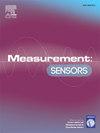Multi-modal GMI applications with annealed nanocrystalline core
Q4 Engineering
引用次数: 0
Abstract
GMI sensors theoretically offer multi-modal sensing, capable of measuring both applied stress and external magnetic fields simultaneously.
Our research explores how the impedance changes in GMI sensors are influenced not only by external magnetic fields but also by changes in the magnetic core's microstructure.
We investigate (Co94Fe6)75Si15B10 amorphous alloy and Fe73.5Cu1Nb3Si13.5B9 nanocrystalline alloy, focusing on flash annealing duration effects (15–300 seconds) under specific stress and current conditions optimized for permeability and coercivity control.
The results show that there is no single best way to process GMI cores for high sensitivity and low noise. Instead, annealing parameters must be tailored to match the sensor's operational range. We discovered that grain size significantly impacts the sensor's sensitivity and operational field range, with larger grains responding better to applied stress. This study highlights that customising annealing time allows for tailoring GMI sensor characteristics to suit specific applications.
具有退火纳米晶核的多模态GMI应用
GMI传感器理论上提供多模态传感,能够同时测量外加应力和外部磁场。我们的研究探讨了GMI传感器的阻抗变化不仅受到外部磁场的影响,而且还受到磁芯微观结构变化的影响。我们研究了(Co94Fe6)75Si15B10非晶合金和Fe73.5Cu1Nb3Si13.5B9纳米晶合金,重点研究了在特定应力和优化磁导率和矫顽力控制的电流条件下闪蒸时间(15-300秒)的影响。结果表明,不存在单一的高灵敏度、低噪声的GMI核处理方法。相反,退火参数必须定制以匹配传感器的工作范围。我们发现,晶粒尺寸对传感器的灵敏度和工作范围有显著影响,晶粒越大,对施加应力的响应越好。这项研究强调,定制退火时间允许定制GMI传感器特性,以适应特定的应用。
本文章由计算机程序翻译,如有差异,请以英文原文为准。
求助全文
约1分钟内获得全文
求助全文
来源期刊

Measurement Sensors
Engineering-Industrial and Manufacturing Engineering
CiteScore
3.10
自引率
0.00%
发文量
184
审稿时长
56 days
 求助内容:
求助内容: 应助结果提醒方式:
应助结果提醒方式:


